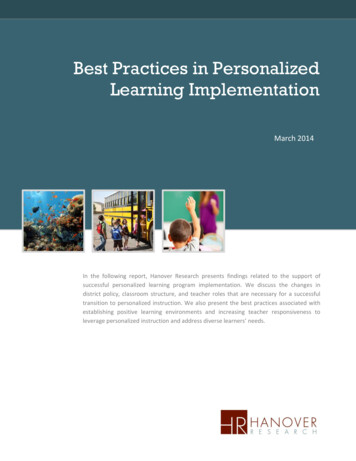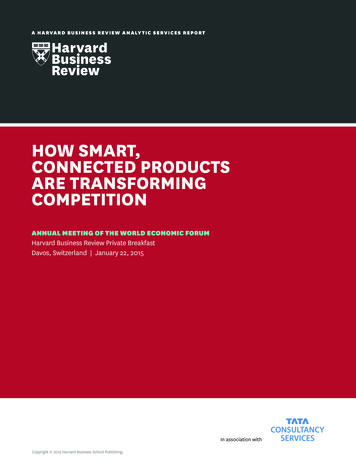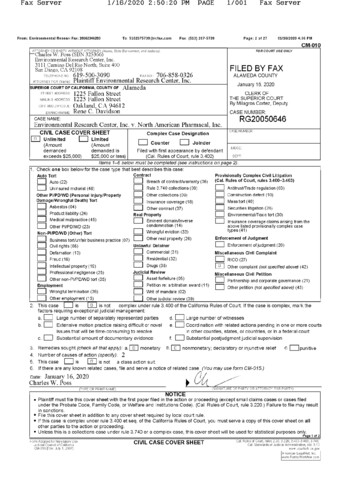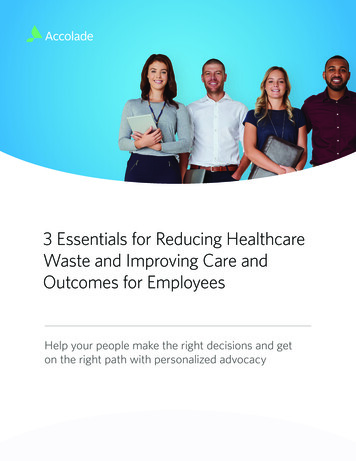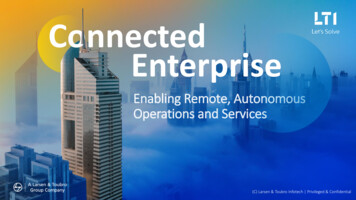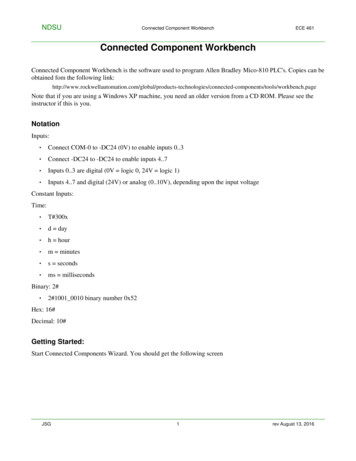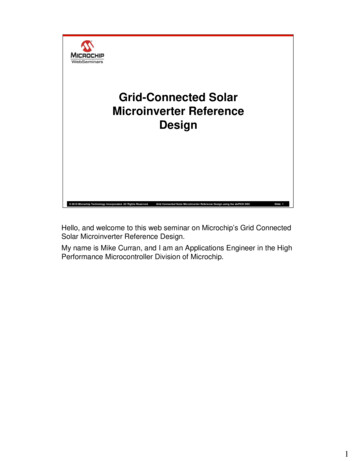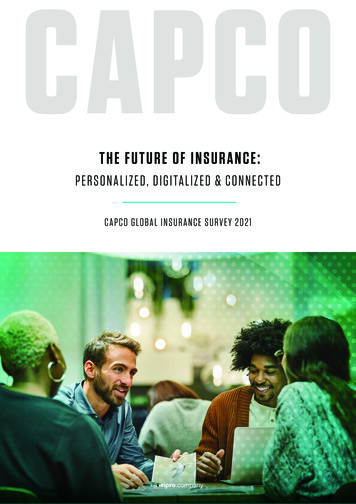
Transcription
T HE FUT U R E O F I N S U R A N C E :PERS O N A L I Z ED , D IG ITA LIZ E D & C O NNECT E DCAP CO G LO BA L I N S U R A N C E S U RV EY 2 0 2 1
TA B L E O F C O NTE NTS0105IntroductionCountry ed States03Executive SummaryEuropeAustriaBelgium04GermanyGlobal Overview:Themes & TrendsTop 10 Policies OwnedSwitzerlandUnited KingdomAPACClaimsHong ailandEducationThe UninsuredCross-sellingT H E FUT UR E O F I N S UR A N C E : P E R S O N A LIZ E D , D IG ITA LIZ E D & C O N N ECT E D /2
I NTR O D U CTI O NIndividuals, companies, industries, and governmentsglobally are currently confronting many changes, someof which look set to alter the nature and tenor of ourdaily lives in fundamental ways. COVID-19, in particular,has clearly been profoundly disruptive, and the reshapedlandscape of the post-pandemic world has yet to fullyreveal itself. However, at a time when our physicalproximity and interactions have been significantlycurtailed, new opportunities and avenues to connect andbuild relationships continue emerging via technologicalinnovation and digitalization.New realities in insurance are coming to the fore as partof this evolutionary shift that will benefit service providersand consumers alike. Our survey of 13 key global marketscaptures a diverse range of today’s consumer sentiments,alongside the key trends, challenges, and opportunitiesthat will shape the industry tomorrow.Many of the world’s insurance markets are growingbeyond the bounds of what was thought possible just 10years ago. Large, traditional market players are coexistingand even partnering with new entrants, including nicheinsurtechs and other companies whose original businessfocus is far removed from the insurance world.Innovation is everywhere. Robots are competing withyour trusted insurance broker or agent to serve complexcustomer needs. Insurers are integrating environmental,social and governance (ESG) factors within their corebusiness operations, as part of underwriting, investing andrisk management decisions, and developing tailored ESGproducts and services.If our survey highlights that there is no one-size-fits-allcustomer – and therefore no one-size-fits-all solution inthe future of insurance – our data does confirm the futurewill be personalized, digitalized, and connected.T H E FUT UR E O F I N S UR A N C E : P E R S O N A LIZ E D , D IG ITA LIZ E D & C O N N ECT E D / 3
M ETH O D O LO GYOur survey was conducted online between April and May 2021 and collected responses from a total of 13,798 individuals.The markets surveyed were the UK, US, Canada, Brazil, Germany, Austria, Switzerland, Belgium, Hong Kong, China,Singapore, Thailand, and Malaysia. Country representative quotas were followed.Survey respondents were drawn from six age demographics: 18-24, 25-34, 35-44, 45-54, 55-64, and 65 . 49% ofrespondents identified as male, 50% identified as female, and 1% identified as other.United KingdomPopulation: 67,215,290Sample Size: 2.002Field Dates: April 13 - 22CanadaPopulation: 38,005,240Sample Size: 1.008Field Dates: April 19 - 26GermanyPopulation: 83,240,520Sample Size: 1.019Field Dates: April 26 - 30BelgiumPopulation: 11,556,000Sample Size: 500Field Dates: April 27- May 6ChinaPopulation: 1,402,112,000Sample Size: 1.009Field Dates: May 11 - 13Hong KongPopulation: 7,481,800Sample Size: 1.000Field Dates: May 12 - 26ThailandPopulation: 69,799,980Sample Size: 1.000Field Dates: May 12 - 25United StatesPopulation: 329,484,120Sample Size: 2.002Field Dates: April 19 - 20BrazilPopulation: 212,599,410Sample Size: 1.007Field Dates: May 11 - 13MalaysiaPopulation: 32,366,000Sample Size: 1.000Field Dates: April 30 - May 25SwitzerlandPopulation: 8,636,900Sample Size: 749Field Dates: April 27 - May 22AustriaPopulation: 8,912,200Sample Size: 501Field Dates: April 26 - 30Source: data.worldbank.orgT H E FUT UR E O F I N S UR A N C E : P E R S O N A LIZ E D , D IG ITA LIZ E D & C O N N ECT E D / 4SingaporePopulation: 5,685,810Sample Size: 1.001Field Dates: April 30 - May 19
EX E CUTI VE S U MMA RYCapco surveyed nearly 14,000 consumers across 13 markets globally to gain a better understanding of publicattitudes toward personal lines of insurance, the key products and services used, and emerging trends.BASED ON OUR FINDINGS, INSURERS SHOULD FOCUS ON THESE FOUR AREAS:1HYPER-PERSONALIZATIONof insuranceholders* surveyed are willingto share personal data to getcheaper insurance premiums2Smart homedevicesEDUCATIONWOMEN FEELLESS CONFIDENTof consumerssurveyed do notfeel well informedabout insurance and the productsavailable today3about the insuranceofferings in 12 out of13 countries4CROSS-SELLINGDIGITALIZATIONOnly40%of insurance customers surveyedhave multiple policies withthe same providerof policyholderssurveyed want a betteronline experiencefrom their insurer65%T H E FUT UR E O F I N S URA N C E : P E R S O N A LIZ E D , D IG ITA LIZ E D & C O N N ECT E D /5*i.e. insurance holders this year and last year.of all respondents, includinguninsured customers, woulduse an app that offers bettertransparency across all financialproducts (bank accounts, pensions,insurance policies) in addition toproviding personalized insights
FOUR OPPORTUNITIES FOR INSURERS1234EDUCATIONHYPERPERSONALIZATIONCROSS SELLINGDIGITALIZATIONEducation isneeded to increaseconsumer knowledgeand engagementHyper-personalizationcould drive bettercustomer outcomesfor certaindemographicsInsurers can boostbrand awareness,repeat business andretention throughcross-sellingThere is thedemand for moresophisticated onlineservices and toolsOur global survey findings reveal that trust in the insurance industry is strong, despite the claims andservicing challenges posed by the COVID-19 pandemic. The way many firms have quickly responded andadapted to customers’ needs in these most trying of times will prove valuable as insurers look to deepenexisting relationships and broaden consumer engagement more generally.It is certainly a positive that 63% of survey respondents consider themselves to be well informed about therange of insurance products available today. However, our research shows there remains a clear opportunityto drive a further uplift both in regards to the levels of financial education and the transparency of policies.Knowledge is power and leads to heightened confidence, more tailored protection and a greater appetiteamong consumers to explore additional insurance options.That sort of empowerment dovetails with the fact that the majority of respondents also want more digitalized,personalized, and connected customer experiences. From a consumer’s perspective, it is too easy forfinancial services products – past the point of initial engagement or need – to feel separate or disconnectedfrom everyday life. Yet, despite sometimes feeling like a safeguard for tomorrow’s problems, insurance is inreality offering protection for the here and now. Technological innovation and digitalization present insurerswith the tools to make this truth more tangible, to the benefit of both sides in terms of the depth, breadth,and relevance of cover.Matthew HutchinsGlobal Insurance Lead, CapcoT H E FUT UR E O F I N S UR A N C E : P E R S O N A LIZ E D , D IG ITA LIZ E D & C O N N ECT E D /6
GLOBAL OVERVIEW:THEMES & TRENDST H E FUT UR E O F I N S UR A N C E : P E R S O N A LIZ E D , D IG ITA LIZ E D & C O N N ECT E D /7
TO P 1 0 I N S U RANC E PO LI C I E S PU R C H AS E DWe asked our survey respondents which insurance policies theyhad bought in the last year.TOP 10 INSURANCE POLICIESPURCHASED IN THE PAST YEAR41%AutoHealth36%Life29%Personal Property25%Travel / Holiday14%Mobile phone / Gadget14%Long-term savings13%Pet insurance10%Income protectionHousehold insuranceUK and Hong Kong respondents were the biggest buyers of petinsurance. The pet care market in APAC is expected to see a10% compound annual growth rate to reach US 132 billion in2027,2 and in the UK, pet insurance offers providers a potential 2.5 billion opportunity in untapped premiums, due to anestimated 48% of dogs and 69% of cats remaining uninsured.37%Thailand and Hong Kong respondents were the biggest buyersof income protection insurance. In June 2020, a survey by theAsia Foundation estimated that 70% of Thailand’s workforcehad seen their monthly income fall by an average of 47%.4Hong Kong’s economy also suffered greatly in 2020, with GDPshrinking to a record 6.1%.5Austria, Switzerland, and Germany were the biggest buyers ofhousehold insurance.6%n: 13,798Auto, health, and life were the most common insurance policiesowned. It should be noted of course that in certain Europeanand APAC markets, certain forms of insurance, such as health,are mandatory. Auto had particularly high ownership in theAmericas, while health and life policies were most prevalent inAPAC.*For the purposes of simplicity, Health included: medical insurance,health insurance through employer, disability insurance, criticalillness insurance, or similar. Life insurance products included: Life &savings insurance, term, whole, universal life products.Personal property insurance came in fourth place, with highownership in the UK, Belgium, and Canada.Despite COVID-19 lockdowns and travel restrictions around theworld, which saw global travel and tourism revenues plummetby nearly 60% year on year,1 travel/holiday insurance came in atfifth place, in joint position with mobile phone/gadget insurance– a product truly born of the digital age. UK respondents inparticular were big spenders in both categories.Long-term savings products were particularly popular withAPAC and Belgium-based respondents.1. avelindustry-still-in-massive-hole/617952. nsuranceplatform/3. ncemarket-worth-potential-%C2%A32--5bn--856.htm4. -to-Recovery.pdf5. yshrank-a-record-6-1-percent-in-2020/T H E FUT UR E O F I N S URA N C E : P E R S O N A LIZ E D , D IG ITA LIZ E D & C O N N ECT E D / 8
C LA I MSRESPONDENTS ARE STILL EXPERIENCING AGE-OLD CLAIMS ISSUESDespite generally high satisfaction with the claims process across the markets surveyed, consumerscomplain about insurance response times and too much l (t2b)Figure 1: Responses to “Have you made an insurance claim in the past two years?” and “How satisfied were you with the claims process?”Claims play a critical part in a customer’s experience andinteraction with their provider. A claim can strengthen anindividual’s relationship with the insurer, potentially extendingit for many years and driving recommendations to family andfriends; or, if poorly handled, it can trigger a swift move toanother provider.As seen in Table 1, our survey identifies health, auto, and lifeinsurance as the most claimed insurance products over the pasttwo years across our respondents globally. Interestingly, GenY (25-34) were the biggest health claimants (43%), whereassecond-generation Baby Boomers (55-64) submitted the mostauto claims (49%). Older Baby Boomers (65 ) made the mostpersonal property insurance claims (31%) and Xennials (35-44)made the most life insurance claims (33%).Top 10 types of insurance claims submittedin the past two yearsHealth%(e.g. Medical insurance, Health insurance through employer, Disabilityinsurance, Critical illness insurance, or similar)34%Auto32%Life(e.g. Life & savings insurance, Term, Whole,Universal life products)19%Mobile/gadget17%Personal property16%Travel/holiday15%Long-term savings13%Pet insurance12%Income protection10%(e.g. Credit)HouseholdTable 1T H E FUT UR E O F I N S URA N C E : P E R S O N A LIZ E D , D IG ITA LIZ E D & C O N N ECT E D / 96%
The acceleration in digitalization and smartphone use (48% ofthe world own one6) has catapulted mobile/gadget from being arelatively niche form of insurance into the survey’s fourth mostclaimed product (and fifth most popular insurance). The leadingclaimants are respondents from Germany (30%) and Brazil(28%), and perhaps predictably, digital native generations –Gen Z (18-24) and Gen Y Millennials (45%) – who are also theleading purchasers of mobile/gadget insurance.Top five issues encounteredduring claims processThe most satisfied region was APAC, with all countries surveyedregistering satisfaction levels in excess of 80%. As manyas 93% of China-based respondents selected either ‘highlysatisfied’ or ‘satisfied’ in response to our question about theirlast claims experience. The least satisfied region was Europe,with 66% of German respondents selecting either ‘highlysatisfied’ or ‘satisfied’; 30% rated their experience as ‘neutral’and 4% were ‘highly unsatisfied’ or ‘unsatisfied.’%Top issues bygeneration surveyedSlow to respond to process42%Gen Y Millennials (25-34), Gen X (4554), Xennials (35-44), Baby Boomers(65 )Too much paperwork to complete process28%Gen Z (18-24)Slow to payout27%No payout24%Insurance premium rose significantly after claiming24%Baby Boomers (55-64)Table 2Pet insurance similarly features prominently, both as apurchased and claimed-for product. Like mobile/gadgetinsurance, it is most favored by younger generations (13%of Gen Z, 11% of Gen Y, 10% of Xennials). The youngergenerations also made the most claims on this type ofinsurance (22% of Gen Z claimed on their pet insurance).The level of claims was higher in the UK (24%) than in othermarkets: as mentioned in the previous chapter, the petinsurance market in the UK is long-established. 45% of UKresidents are pet owners (with over 3 million getting a petsince the pandemic struck7), and UK pet insurance claims havealmost doubled in the past six years, from 452 million in 2012to 815 million in 2019, with the average claim totaling 793.8Our respondents were generally positive about recent claimsexperiences, but there is evidently room for improvement.Looking at the reasons for dissatisfaction with a claim, three ofthe top five cited touch upon elements that could be supportedby technology (see Table 2). Innovations, such as machinelearning and AI, are improving the customer experience viadigital claims handling capability, speeding up tasks, andreducing fraud and forms of data leakage. Blockchain is alsostarting to be used for managing claims as part of Know YourCustomer (KYC) assessments and automated claims submissionand processing.From a customer perspective, the issues cited by respondentsreinforce the importance of both financial literacy andsimplification when it comes to insurance. The digital era haseroded customers’ willingness to engage in deep reading,meaning they are less disposed to thoroughly check throughpaperwork. It has also changed expectations on how quickly keyT H E FUT UR E O F I N S UR A N C E : P E R S O N A LIZ E D , D IG ITA LIZ E D & C O N N ECT E D /10
information can be accessed and claims issues solved.The events of 2020, which led to exceptionally hefty claims,have demonstrated the capacity of ‘black swan’ occurrences –such as COVID-19 – and more predictable developments (likeclimate change) to expose the often complex and cumbersomenature of claims processes. While we do not know the full costof the pandemic, some data can shed light on the magnitudeof its effect. Lloyds of London priced industry costs from 2020at 6.2 billion,9 making it the market’s most expensive year forthree centuries. Similarly, Swiss Re quantified the natural andman-made catastrophes from 2020 at 89 billion, naming it thefifth costliest year for insurers since 1970.10 2021 is similarlyalready looking like an expensive year for insurers.However, there is a clear opportunity for additional innovation toenhance the claims process. Customer pain points can also bereduced by keeping them informed at every stage of their claim.This is not just a case of creating digital products, but ensuringhelp and support is provided in a number of different forms tosupport all consumer needs throughout the policy ls-pet-insurance.html8.‘Is pet insurance worth it?’, Financial Times, July 10, ational/2021/03/30/607715.htm10. esearch/sigma-2021-01.htmlT H E FUT UR E O F I N S UR A N C E : P E R S O N A LIZ E D , D IG ITA LIZ E D & C O N N ECT E D / 11
D I GI TA LI ZATI O N6 OUT OF 10 POLICYHOLDING RESPONDENTS WANT A BETTER ONLINE INSURANCE EXPERIENCEDo you want abetter onlineexperience fromyour insuranceprovider?CountriesFigure 1: Question was asked to policyownersWhile in the past insurance was considered to be less digitallyadvanced than some industries, the accelerating digitalizationof daily experiences and activities, coupled more recentlywith the COVID-19 pandemic, has challenged conventionand is increasingly driving customer journeys down digitalpaths. For example, Lemonade Inc., a US and Europe-servinginsurtech, tells its website visitors to ‘forget everythingyou know about insurance’ and ‘get insured in seconds’.11‘Insurance, but simple,’ says European digital insurer WeFox.Tesla urges consumers to ‘get a quote with Tesla Insurance forcompetitive rates in as little as one minute’.12 Convenience andtransparency have become vital in insurance, and digitalizationis allowing industry players to significantly enhance both.Where do you typically look to findinsurance products? (multiple choice question)BaseTotal12443From an insurance agent38%Direct from an insurer38%Through a price comparison or reviewaggregator website32%Through an insurance broker24%My bank23%Table 1When buying insurance what is your mostimportant decision factor?BaseTotal12512Value for money30%Ability of offer to meet your needs19%Trust in brand18%Advice14%Ease of doing business (e.g. application process, ability topurchase digitally and managing my policy online)Rewards/points/free gift or extra services(wellness platform, telehealth)None of the above11%6%3%Table 2Globally, six out of 10 have access to the internet,13 andaccording to our survey, six out of 10 people want a betteronline experience from their insurance provider (Figure 1).This desire was strongest in APAC markets, where respondentsare also most in favor of personal data sharing and using apps.However, this does not mean face-to-face advice is going awayany time soon. As shown in Table 1, our respondents indicatedthat they look to source insurance products from a range ofsources, and that the most important decision factor whenbuying insurance was ‘value for money’ (30%) across everygeneration, gender, level of industry knowledge, and educationalbackground (Table 2).T H E FUT UR E O F I N S UR A N C E : P E R S O N A LIZ E D , D IG ITA LIZ E D & C O N N ECT E D / 12
11. https://www.lemonade.com/fr/en/?f 112. https://www.tesla.com/en GB/insurance13. -population-worldwide/T H E FUT UR E O F I N S UR A N C E : P E R S O N A LIZ E D , D IG ITA LIZ E D & C O N N ECT E D / 13
H YP E R- P E R S O NA LI ZATI O NOur survey reveals the potential for hyper-personalization to demonstrate value for money and productrelevance to consumers, especially in a time of rising premiums and claims.Personal data sharing is a key method to enable hyperpersonalization of insurance products and services. The morewidely established conduits for personal data sharing in mostinsurance markets today are fitness and health tests andtelematics (black box technology).Globally, 72% said they would share some form of personaldata with their insurer (Table 1). However, personal data sharingcan vary greatly depending on the respondent’s gender, age,country, and industry knowledge-level, as well as the personaldata asset in question. For example, globally we found that75% of men surveyed would share some form of personaldata, compared to 68% of women surveyed. On the otherhand, in the APAC region, data sharing in exchange for amore personalized insurance product or premium was moreenthusiastically embraced. In Hong Kong, for example, 92% offemale respondents selected one of the personal data sharingoptions listed.Would you consider one of the followingmethods to get a more personalizedinsurance product or premium?%Having a fitness or health test33%Using a smart device in my home32%Wearing a smart watch or another wirelesswearable technology29%Sharing my social media data20%Putting a black box in my vehicle19%None of the above28%Howard Taylor, a Global RegulatoryDelivery Lead based in Capco’s London office anda newly appointed Commissioner at the UK FinancialInclusion Commission, notes that while there are benefits to begleaned from the personalization of insurance products for bothinsurers and consumers, there are risks;‘‘Pre-existing health conditions oftenmean a disadvantage when it comes toaccessing a cheaper premium; this isexacerbated by an often poorly-tailoredcustomer journey. In the UK, 3 millionpeople with disabilities have been turneddown for insurance or have been chargedextra. Citizen’s Advice research foundthat only 1 in 3 people with severemental health problems have homeinsurance or a savings account.Financial institutions need to make surethat vulnerable customers are not anafterthought but considered throughoutthe whole product and customerexperience lifecycle. When designingand implementing a new product, firmsshould apply a ‘vulnerability lens’,assessing on a rolling basis whether theiroffering is accessible to all.TOTAL: 12,512 (Policy-owning respondents)Table 1T H E FUT UR E O F I N S UR A N C E : P E R S O N A LIZ E D , D IG ITA LIZ E D & C O N N ECT E D / 14’’
APPSThere was a greater alignment of attitudes across the 13 countries surveyed when it comes to using personalized apps that providetransparency and insights into all financial products owned, such as savings, bank accounts, pensions, and insurance policies. 66% ofpolicy-owning respondents responded in the affirmative – although just 8% answered ‘I already use one,’ highlighting the scope of thisindustry opportunity in this area (Figure 1).Would you use anapp that gave youbetter visibility ofall your financialproducts (bankaccounts, pensions,insurance policies)and providedtailored insights?CountriesFigure 1: Question asked to policyholders. These respondents answered in the affirmative.Demand for personalized apps was strongest in the APAC countries in surveyed, and typically amongst those that were male-identifying;and among respondents based in Europe and the Americas, the young. Conversely, older generations of policyholder in APAC werekeener on such apps than their juniors (Figure 2).App UsageIntention(Gender)App UsageIntention(Age)CountriesFigure 2: Responses to “Would you use an app that gave you better visibility of all your financial products (bank accounts, pensions, insurance policies)and provided personalized insights?”T H E FUT UR E O F I N S UR A N C E : P E R S O N A LIZ E D , D IG ITA LIZ E D & C O N N ECT E D / 15
‘‘Matthew Hutchins, Capco Partner andGlobal Insurance Lead, says:The data from our survey shows thatrespondents want a more connectedcustomer experience that goes beyondthe insurance space into other areas offinancial services. Insurers can achievethis by developing digitally focusedtools that educate the customer, providepersonalized support and financialinformation.Different customer segments havedifferent needs and preferences when itcomes to the sharing of personal data,however. Insurers could devise ‘two-waycontracts’ to better understand the extentof customer willingness to share data inexchange for more unique usage-basedproducts while providing reassurancesregarding the privacy and fair use ofdata.As the insurance industry becomesincreasingly data-centric, we could seethe emergence of more niche insuranceofferings to cater for consumers.’’T H E FUT UR E O F I N S UR A N C E : P E R S O N A LIZ E D , D IG ITA LIZ E D & C O N N ECT E D / 16
E D U CATI O NOVER A THIRD OF RESPONDENTS DO NOT FEEL WELL-INFORMED ABOUT INSURANCEInsurance by its very nature is a complex industry. Our survey demonstrates that many people worldwide outsource their policy decisionmaking to a professional, such as a broker (24%) or agent (38%). Others visit a price comparison website (32%) or go direct to theinsurer (38%) where they only need to consider a limited range of options without a need for deeper industry knowledge. Once theirpayment schedule is set up, most consumers rarely think about their policy again until they encounter an issue, must make a claim, orneed to renew.Our survey found 37% of respondents do not feel well-informed about insurance and the products available today (Figure 1). This levelof uncertainty is particularly pronounced among women/female identifying respondents (41%), single policy holders (42%), the 18- to24-year-old Gen Z demographic (43%) and the uninsured (71%).Do you feelwell-informed aboutabout the range ofinsurance productsavailable today?(“Yes”)Gender gapbetween “Yes”answersCountriesFigure 1: Question asked to all survey respondentsAPAC respondents considered themselves the best informed, although Swiss respondents were also highly confident. In Thailand,women were more confident than men – the only country surveyed where we found this to be the case. While we believe insurersshould take this gender confidence gap with a pinch of salt (studies have found that women display lower ‘self-rates’ and unfavorableattitudes to their ability or performance than men14 – and studies have also found that compared with women, men are more prone todisplaying optimism bias, considering themselves less threatened by the risks15), there is nevertheless a gap, which could be hinderingwomen’s engagement with insurance and therefore their overall insurance coverage protection. A US report by Life Happens and LIMRAin 2021 found that just 47% of women have life coverage versus 58% of men.16 We have also heard that women’s careers and financeshave been disproportionately affected by the pandemic.17T H E FUT UR E O F I N S URA N C E : P E R S O N A LIZ E D , D IG ITA LIZ E D & C O N N ECT E D / 17
When assessing the responses to our question “Do you feel well-informed about the range of insurance products available today?”, onthe basis of education-level, self-assurance tended to be more evident among the higher-educated respondents. Two-thirds (66%) ofuniversity-educated respondents felt well-informed about the industry in comparison to 57% of high-school graduates (Figure 2).Figure 2: ‘Yes’ answers to “Do you feel well-informed about the range of insurance products available today” question that was asked to all surveyedHowever, 25% of those who participated in further education (apprenticeship/college/university or higher) selected ‘don’t know’ whenasked the question “As a result of COVID-19, do you feel that your existing insurance products provide the appropriate amount ofprotection?”.Our survey has revealed there is a big incentive for insurers to provide additional guidance around insurance policies; regardless of theircountry or origin, respondents who feel more confident about their knowledge level tend to buy more insurance than those who lackconfidence. 74% of respondents owning four or more policies felt well-informed about the range of insurance products today, comparedto 58% with a single policy. Just 29% of uninsured respondents felt well-informed.14. Ross, A. J, Scott, G., and Bruce, C. D (2012). The Gender Confidence Gap in Fractions Knowledge: Gender Differences in Student BeliefAchievement Relationships. School Science and Mathematics, Vol 12 (5), 19498594.2012.00144.x15. Tali Sharot, “Optimist bias”, Current Biology, Volume 21, Issue 23, 6 December 2011, Pages R941-R945, S096098221101191216. -women-should-know/17. lT H E FUT UR E O F I N S UR A N C E : P E R S O N A LIZ E D , D IG ITA LIZ E D & C O N N ECT E D / 18
T H E U NI NS U R E DLACK OF FINANCIAL LITERACY IS A KEY BARRIER TO POLICY OWNERSHIPAfter answering some basic background questions, such as age, gender and education, respondents were asked whether they currentlyowned an insurance policy.18 1,286 respondents answered in the negative. 71% of these respondents had never had an insurancepolicy before, and 71% answered ‘no’ or ‘not sure’ to the question “Do you feel well-informed about the range of insurance productsavailable today?”.While cost is a significant factor in policy ownership, the results of our survey suggest that insurance education and financial literacycould shift perceptions around the value of insurance, and in turn prompt a positive reassessment of the costs involved – and hencedrive increased engagement and uptake.PERCENTAGE OF UNINSURED RESPONDENTS IN COUNTRIES K)(Malaysia)TOP FIVE REASONS WHY RESPONDENTSARE UNINSURED010203040528%I don’t know much about insurance13%11%(USA)(Canada)WOULD YOU USE AN APP THAT GAVE YOUBETTER VISIBILITY OF ALL YOUR FINANCIALPRODUCTS (BANK ACCOUNTS, PENSIONS,INSURANCE POLICIES) AND PROVIDEDPERSONALIZED INSIGHTS?Yes51%24%It is unnecessary18%Premiums are expensiveI can’t understand whichinsurance I should buyI don’t trustinsurance companies9%(Singapore)15%I alreadyuse one8%No41%12%n:1286In Germany, Austria, Switzerland and Belgium, insurance is mandatory
the future of insurance - our data does confirm the future will be personalized, digitalized, and connected. THE FUTURE OF INSURANCE: PERSONALIZED, DIGITALIZED & CONNECTED / 4 . perspective, this is becoming possible to achieve through Big Data analytics. Figure 5: Question asked to policyholders Yes 83% I already use one 9% No 8% WOULD YOU .
